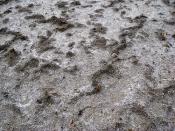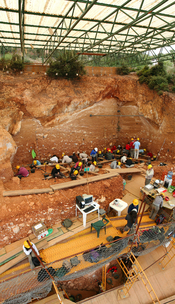Archaeologists do not just dig holes of random sizes until something is found. The dimensions of each hole is determined before excavation begins and is sectioned off with rope, usually in one by one meter units. Once the excavation starts the hole is dug down evenly in levels. It is imperative when digging the unit to keep all walls smooth and straight and to excavate soils of different colors within a level separately. These areas of different soil composition are designated as features and are caused by rodents, fire, organic material that has decayed and human activities. All soil removed is then placed in a sieve, which is a screen that lets soil pass through and traps artifacts that would go otherwise unnoticed like small flaked stones and fish and rodent bones. All artifacts and bones found in there original resting place are mapped and excavated using a mason's trowel paint brushes and even chop sticks to avoid any damage.
All charcoal found, which is used for radio-carbon dating is placed in tinfoil and never touched by hand to avoid contamination. While the excavation is taking place, the more tedious aspect of archaeology, recording ones findings is also occurring. Recording and mapping all findings during excavation, while time consuming, is the most important task an archaeologist has. Each level of a unit is described in various ways, including, start and stop depths, soil color and texture, and a list of what was bagged and removed from the hole, for example charcoal, soil samples, artifacts and bones. Every artifact and bone is placed in a bag designated to a unit and level, which intern receives a catalog number. When features or artifact and bone concentrations occur a plan map of the level is drawn to show there specific location and...


